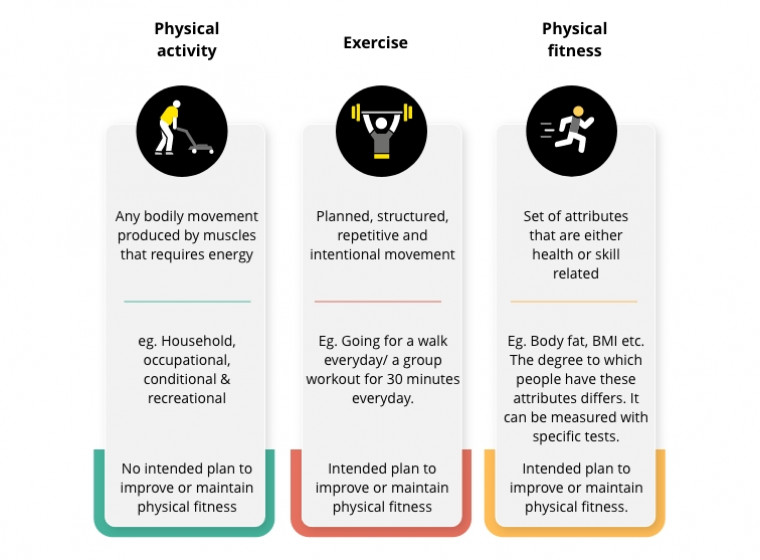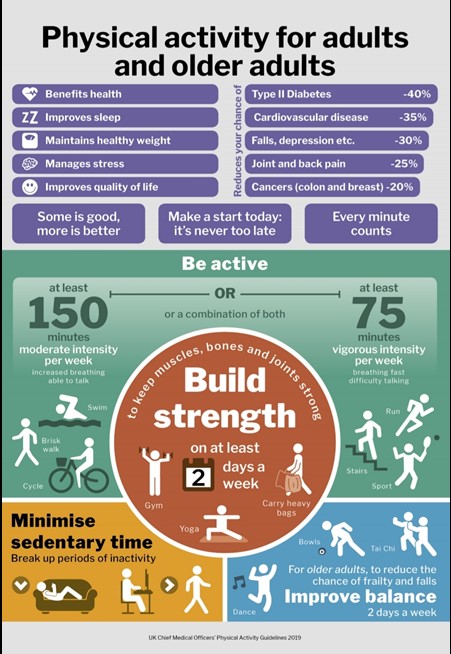Physical fitness and activity guidelines
Key components for overall physical health and wellbeing.
What is physical fitness?
Physical fitness is a state of health and wellbeing. The main components are:
- Aerobic fitness
- Muscular strength and endurance
- Mobility
- Body composition
Physical fitness is generally achieved through proper nutrition, moderate to vigorous physical exercise, and sufficient rest. It is your ability to perform your daily duties effectively in physical work, training and other activities. Poor physical fitness is a notable risk factor for a vast range of medical conditions. Poor aerobic fitness in particular is one of the biggest risk factors for cardiovascular disease and mortality.
Your fitness
Physical activity and exercise are not only important if you are an athlete or a member of the Defence Force, they are key components of overall health and wellbeing. Staying fit can sometimes get harder as we get busy, and often as we get older; however, prioritising your health is important at any age.
Your level of physical activity may fluctuate depending on lifestyle, the demands of work, and the priority placed on physical fitness and health. It is much easier to maintain a level of fitness through regular training as opposed to trying to get your fitness back after losing it.
When deciding what fitness regime or training programme is best for you, it is important to take into account your lifestyle, goals and current levels of health and fitness. Questions to consider are:
- What is my current fitness level?
- What injuries/issues do I have?
- What do I want to train for?
- What does my lifestyle involve and what are the barriers?
- What activity do I like and dislike?
- How can I consistently add exercise into my lifestyle that is achievable and enjoyable?

Physical activity guidelines
There are several guidelines available on the amount of physical activity that people should aim for.
The Ministry of Health recommends doing at least two and a half hours of moderate or one hour and one quarter hours of vigorous physical activity spread throughout the week, plus some muscle-strengthening activities on at least two days each week. This is considered a good baseline for physical health. For extra health benefits, it is recommended that we aim for five hours of moderate or two and a half hours of vigorous physical activity spread throughout the week.
- Moderate intensity activity causes a slight, but noticeable, increase in breath and heart rate. You can still carry on a conversation.
- Vigorous intensity activity makes you out of breath - you can't do these activities and talk at the same time.
However, these guidelines are a baseline for maintaining general health and should be considered an absolute minimum. For military (specifically army), personnel should refer to DFO(A) Vol 7 Chpt 5 Section 4. By following military guidelines, this better reflects the unique environment that personnel encounter. Physical fitness should be a priority for military per due to the chance of being deployed on operation at any given time. This is reflected in criteria such as the RFL (Required Fitness Level) and CFT (Combat Fitness Test) which must be passed every 12 months, or before overseas deployment, in order to maintain currency.
The best available measure of cardiovascular fitness is considered to be VO2 max, which can be manually measured or calculated from endurance on tasks. It can also be predicted and monitored using some smart watches (these work by comparing actual and predicted heart rate for a certain level of exertion). The RFL is designed to reflect adequate VO2 max levels to maintain endurance on field operations. A healthy VO2 max range, for age and gender, is outlined below:
Age |
Male VO2max |
Female VO2max |
| 20-29 | 43-52 | 33-42 |
| 30-39 | 39-48 | 30-38 |
| 40-49 | 36-44 | 26-35 |
| 50-59 | 34-41 | 24-33 |
| 60-69 | 31-38 | 22-30 |
For army personnel, the DFO(A) Vol 7 Chap 5 Section 4 states that members of the Regular Force are to carry out a minimum of three PT (physical training) sessions each week, regardless of rank. However, for optimal training, per should engage in four to five conditioning sessions each week, aligned to a specifically designed programme. This includes battle training sessions within the weekly training(s). Reserve force members are to conduct their own PT to maintain the required fitness level and battlefield fitness level.

- Spread your movement out throughout the day and be conscious of how much time you spend sitting. Increase your activity by parking your car further away, walking up stairs rather than taking the lift, setting an alarm to move every 40 minutes if your role is sedentary, or by setting a goal of steps you want to achieve each day using your smart watch or phone.
- Focus on aerobic exercise (heart rate should be elevated but you can still hold a conversation). This does not mean that high intensity training should be excluded; rather, there should be a component of both. Having a focus on aerobic exercise means that you can dedicate more time to being active, without getting too fatigued. A useful way to do this is to increase light and moderate intensity activities in daily life, whilst using vigorous intensity activities for dedicated training sessions. Refer to the table below to see how much energy different activities require.
Physical activity can be measured using METs (the metabolic equivalent of tasks). This is the rate of energy expended during an activity, compared to the rate of energy expended at rest. 1 MET is the metabolic cost of sitting quietly at rest. An 8 MET activity, such as playing a game of basketball, requires 8 times the amount of energy expenditure compared to rest.
Physical Activity
MET
Light intensity Activities <3 Writing, desk work using computer 1.5 Walking slowly 2.0 Moderate intensity activities 3-6 Walking (4.8km/h) 3.0 Sweeping and mopping floors, vacuuming carpets 3 – 3.5 Yoga (asanas and pranayama) 3.3 Weight lifting (moderate intensity) 5.0 Sexual activity 5.8 Vigorous intensity activities 6 + Aerobic dancing, medium effort 6.0 Cycling on flat, 16-19km/h, light effort 6.0 Basketball game 8.0 Swimming moderately to hard 8 - 11.0 Jogging (9 km/h) 8.8 Skipping (66p/m) 9.8 Jogging (11km/h) 11.2 - Schedule physical activity like a meeting or appointment. Fit physical activity into your daily lifestyle, e.g. a 30 min walk at lunchtime or before work. Training in the morning can be helpful in case something unexpected comes up. Not the master of your calendar? Suggest meetings with peers are taken on the walk track and use your phone to record notes, you may inspire others to do the same!
- Include some higher intensity exercise 1-2 times a week. Because of the high intensity the duration of the session should be shorter than your lower intensity sessions.
- Add muscle-strengthening activities to your routine. This could be achieved at the gym, through body-weight exercises, or combined with activities such as gardening.
- Listen to your body. If you are tired or feel an injury or illness approaching, adjust
your program to facilitate recovery. This may include incorporating rest or reducing the intensity of your training session(s). It is important to understand and recognise the difference between mental fatigue and physically needing rest - doing physical activity can re-energise your mind and alleviate mental fatigue.
Top Tips for Staying Active
- Set a goal - Are you wanting to deploy? Have you always wanted to crack the RFL 100's Club? Or ever wanted to try a triathlon? With a little perseverance and some perspiration, you can get there. Make your goals measurable and achievable, and get some SME advice from your regional gym staff.
- Make a day of it - it's easy to add activity to your weekends. Organise a barrack sports day, an impromptu game of touch or a walk/ run with mates! How much better will that BBQ taste once you've done the mahi to earn it?
- Be active with others - rope in your neighbours, friends and whanau and you can all have a great time. Street cricket, anyone? Or find a local sports team you are interested in joining.
- Try a range of activities - team sports not for you? Try releasing your energy with some kickboxing or BJJ instead - go for a hunt (without the quad) - or harness it with some relaxing yoga techniques.
- Have fun - if Unit PT is your only exposure to physical activity, don't forget there are other options you can add it in to your week. Go tramping, try horse riding, get out on the water for kayaking or paddle boarding, take a dance class. If you enjoy it, you will stick with it.
- Small changes for healthy habits - you could:
- build healthy habits into your post work routine - take the kids/ dog for a walk to the park, do some mahi in the garden;
- swap your coffee breaks at work with walking breaks;
- try using a standing desk if available; and/or
- bike to work every second day (or daily!) or park further away from work to increase your daily movement.
- Make it normal - physical activity should be a normal part of your day, and not a chore. Simple things like walking or cycling to the shops or to work, can make a big difference.
- 'Snack' on activities - be mindful of how much activity is in each day - it can be easy to 'sit' the day away at your desk... short periods of activity still count towards your weekly activity level. Even small things, like taking the stairs instead of the lift, add up!
How much energy is used in daily activities?
Not all activity is the same. Technological advances have significantly improved our efficiency and quality of life, and daily activities that used to take long periods of time now take considerably less time and use less physical exertion. We drive to work, we take the lift and we have robotic vacuum cleaners and lawn mowers that can push themselves. We have become an increasingly sedentary society. However, we can still incorporate physical activity by opting for more physical means of achieving tasks, or dedicating time to specific fitness-related goals.
Goal setting
Setting achievable goals is one of the most effective ways to keep yourself accountable. For general guidance on setting and achieving your goals, click here.
If you are having problems keeping on top of your fitness, discuss this with your Command, NZDF physical training instructor (PTI) or get in touch with a civilian physical trainer who can help you develop an individualised fitness plan.
Service personnel are required to keep a minimum level of fitness to be able to do their job. Each Service has different types of fitness tests designed to encourage you to maintain an acceptable level of personal fitness for your age and gender. Click here for details.